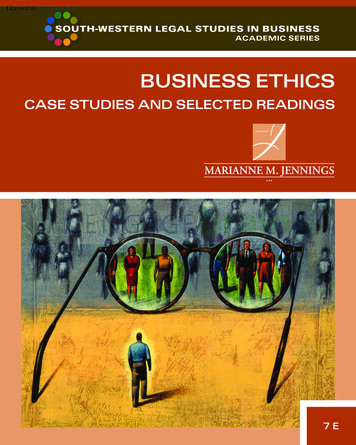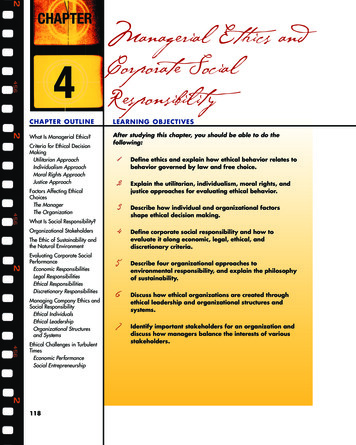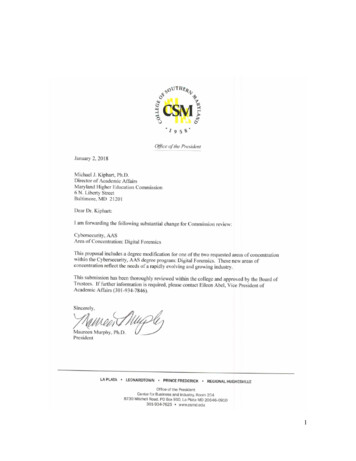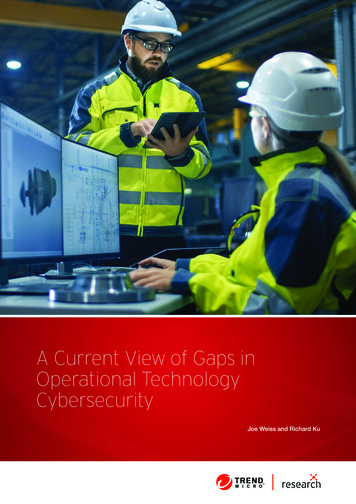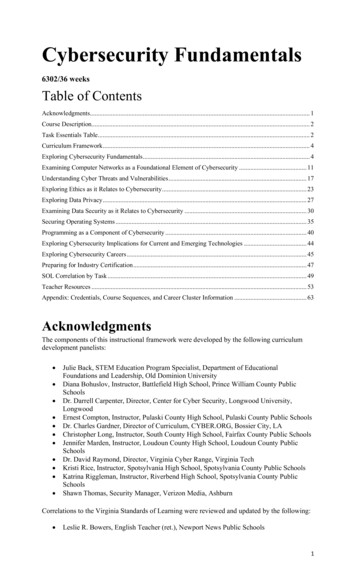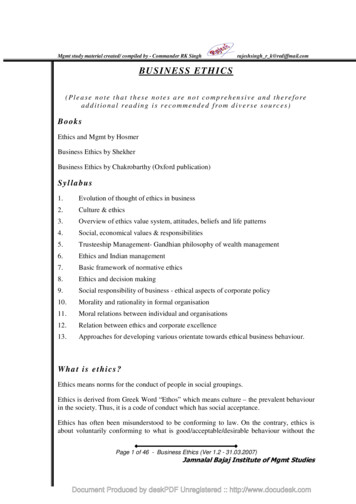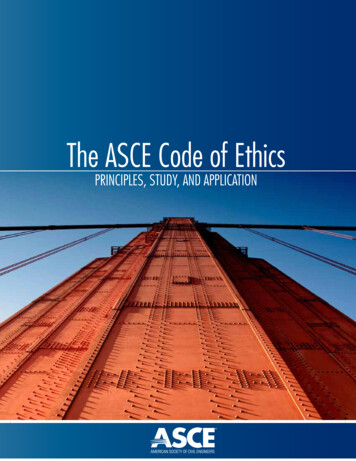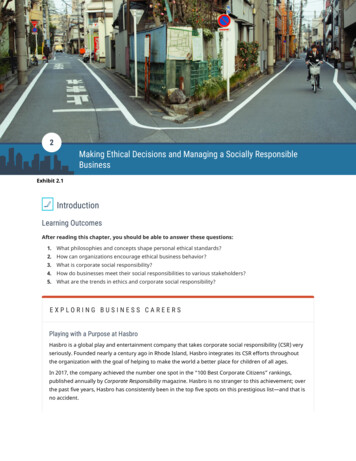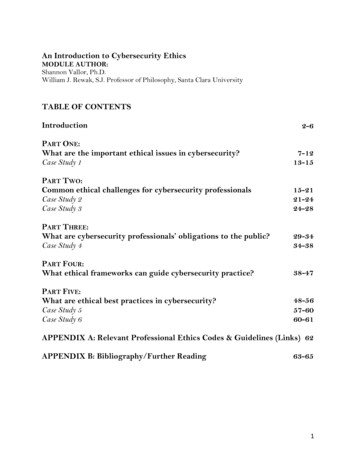
Transcription
An Introduction to Cybersecurity EthicsMODULE AUTHOR:Shannon Vallor, Ph.D.William J. Rewak, S.J. Professor of Philosophy, Santa Clara UniversityTABLE OF CONTENTSIntroduction2-6PART ONE:What are the important ethical issues in cybersecurity?Case Study 17-1213-15PART TWO:Common ethical challenges for cybersecurity professionalsCase Study 2Case Study 315-2121-2424-28PART THREE:What are cybersecurity professionals’ obligations to the public?Case Study 429-3434-38PART FOUR:What ethical frameworks can guide cybersecurity practice?38-47PART FIVE:What are ethical best practices in cybersecurity?Case Study 5Case Study 648-5657-6060-61APPENDIX A: Relevant Professional Ethics Codes & Guidelines (Links) 62APPENDIX B: Bibliography/Further Reading63-651
An Introduction to Cybersecurity EthicsMODULE AUTHOR:Shannon Vallor, Ph.D.William J. Rewak, S.J. Professor of Philosophy, Santa Clara University1. What do we mean when we talk about ‘ethics’?Ethics in the broadest sense refers to the concern that humans have always had for figuring outhow best to live. The philosopher Socrates is quoted as saying in 399 B.C. that “the mostimportant thing is not life, but the good life.”1 We would all like to avoid a bad life, one that isshameful and sad, fundamentally lacking in worthy achievements, unredeemed by love,kindness, beauty, friendship, courage, honor, joy, or grace. Yet what is the best way to obtainthe opposite of this – a life that is not only acceptable, but even excellent and worthy ofadmiration? How do we identify a good life, one worth choosing from among all the differentways of living that lay open to us? This is the question that the study of ethics attempts toanswer.Today, the study of ethics can be found in many different places. As an academic field of study,it belongs primarily to the discipline of philosophy, where it is studied either on a theoreticallevel (‘what is the best theory of the good life?’) or on a practical, applied level as will be ourfocus (‘how should we act in this or that situation, based upon our best theories of ethics?’). Incommunity life, ethics is pursued through diverse cultural, political and religious ideals andpractices, through which particular social groups give their members guidance about how bestto live. On a personal level, it can be found in an individual’s self-reflection and continualstrivings to become a better person. In work life, it is often formulated in formal codes orstandards to which all members of a profession are held, such as those of medical or legal ethics.Professional ethics is also taught in dedicated courses, such as business ethics. Ethics can alsobe infused into courses such as this one.2. What does ethics have to do with technology?There is a growing international consensus that ethics is of increasing importance to educationin technical fields, and that it must become part of the language that technologists arecomfortable using. Today, the world’s largest technical professional organization, IEEE (theInstitute for Electrical and Electronics Engineers), has an entire division devoted just totechnology ethics.2 In 2014 IEEE began holding its own international conferences on ethicsin engineering, science, and technology practice. To supplement its overarching professionalcode of ethics, IEEE is also working on new ethical standards in emerging areas such as AI,robotics, and data management.What is driving this growing focus on technology ethics? What is the reasoning behind it? Thebasic rationale is really quite simple. Technology increasingly shapes how human beingsseek the good life, and with what degree of success. Well-designed and well-used technologiescan make it easier for people to live well (for example, by allowing more efficient use anddistribution of essential resources for a good life, such as food, water, energy, or medical care).Poorly designed or misused technologies can make it harder to live well (for example, by12Plato, Crito 48b.https://techethics.ieee.org2
toxifying our environment, or by reinforcing unsafe, unhealthy or antisocial habits).Technologies are not ethically ‘neutral’, for they reflect the values that we ‘bake in’ to themwith our design choices, as well as the values which guide our distribution and use of them.Technologies both reveal and shape what humans value, what we think is ‘good’ in life andworth seeking.Of course, this always been true; technology has never been separate from our ideas about thegood life. We don’t build or invest in a technology hoping it will make no one’s life better, orhoping that it makes all our lives worse. So what is new, then? Why is ethics now such animportant topic in technical contexts, more so than ever?The answer has partly to do with the unprecedented speeds and scales at which technicaladvances are transforming the social fabric of our lives, and the inability of regulators andlawmakers to keep up with these changes. Laws and regulations have historically beenimportant instruments of preserving the good life within a society, but today they are beingoutpaced by the speed, scale, and complexity of new technological developments and their oftenhard-to-predict social impacts.Additionally, many lawmakers lack the technical expertise needed to guide effectivetechnology policy. This means that technical experts are increasingly called upon to helpanticipate those social impacts and to think proactively about how their technical choices arelikely to impact human lives. This means making ethical design and implementation choices ina dynamic, complex environment where the few legal ‘handrails’ that exist to guide thosechoices are often outdated and inadequate to safeguard public well-being.For example: face- and voice-recognition algorithms can now be used to track and create alasting digital record of your movements and actions in public, even in places where previouslyyou would have felt more or less anonymous. There is no consistent legal frameworkgoverning this kind of data collection, even though such data could potentially be used toexpose a person’s medical history (by recording which medical and mental health facilities theyvisit), their religiosity (by recording how frequently they attend services and where), theirstatus as a victim of violence (by recording visits to a victims services agency) or othersensitive information, up to and including the content of their personal conversations in thestreet. What does a person given access to all that data, or tasked with keeping it secure,need to understand about its ethical significance and power to affect a person’s life?Another factor driving the recent explosion of interest in technology ethics is the way in which21st century technologies are reshaping the global distribution of power, justice, andresponsibility. Companies such as Facebook, Google, Amazon, Apple, and Microsoft are nowseen as having levels of global political influence comparable to, or in some cases greater than,that of states and nations. In the wake of revelations about the unexpected impact of socialmedia and private data analytics on 2017 elections around the globe, the idea that technologycompanies can safely focus on profits alone, leaving the job of protecting the public interestwholly to government, is increasingly seen as naïve and potentially destructive to socialflourishing.Not only does technology greatly impact our opportunities for living a good life, but itspositive and negative impacts are often distributed unevenly among individuals and3
groups. Technologies can generate widely disparate impacts, creating ‘winners’ and ‘losers’ inthe social lottery or magnifying existing inequalities, as when the life-enhancing benefits of anew technology are enjoyed only by citizens of wealthy nations while the life-degradingburdens of environmental contamination produced by its manufacture fall upon citizens ofpoorer nations. In other cases, technologies can help to create fairer and more just socialarrangements, or create new access to means of living well, as when cheap, portable solarpower is used to allow children in rural villages without electric power to learn to read andstudy after dark.How do we ensure that access to the enormous benefits promised by new technologies,and exposure to their risks, are distributed in the right way? This is a question abouttechnology justice. Justice is not only a matter of law, it is also even more fundamentally amatter of ethics.3. What does ethics have to do with cybersecurity?Cybersecurity practices have as their aim the securing—that is, the keeping safe—of data,computer systems and networks (software and hardware). While those data, systems, andnetworks might have some economic or other value in and of themselves, what cybersecuritypractices primarily protect are the integrity, functionality, and reliability of humaninstitutions/practices that rely upon such data, systems, and networks. And in protecting thoseinstitutions and practices, cybersecurity professionals in turn are protecting the lives andhappiness of the human beings who depend upon them.If you are a cybersecurity professional tasked with securing a hospital’s network and criticaldata from invasion and attack, you are intimately involved in protecting sick patients, even ifyou have no medical training. Patients’ privacy, health, even their survival can hinge upon yoursuccess or failure. In many cases the well-being of patients’ families and caregivers is beingshielded by your practice as well. This is a particularly stark example, but cybersecuritypractices and professionals are also critical to the protection of credit users, students, powerand water customers, voters, investors, inventors, drivers, train and airplane passengers—basically all of us.This means that ethical issues are at the core of cybersecurity practices, because thesepractices are increasingly required to secure and shield the ability of human individuals andgroups to live well. And given the increasing complexity and difficulty of securing online dataand systems across a proliferating landscape of cloud computing services, WiFi-enabled mobiledevices, and ‘smart’ objects—from a multiplicity of hostile actors exploiting lax or underresourced security controls—the ethical responsibility to protect others that is borne bycybersecurity professionals is an increasingly heavy burden.For example, which of these life-impacting events might result from cybersecuritypractices?A. Kent, a hard-working first-generation college senior, has just requested that copies of hisuniversity transcript be sent to the ten graduate schools to which he has applied. Kent does notknow that he was recently the victim of a malicious and undetected intruder into his4
university’s network; as a prank, the intruder changed a random selection of students’ coursegrades to an ‘F.’B. Desiree, a middle-aged mother of two, applies for a loan to start a new small business. Shehas a promising and novel business plan, a nest egg of savings, and a few key investors who areready to sign on. The bank checks her credit report on file with a major credit bureau, finds itexcellent, and approves her startup loan; her investors commit and she launches what in tenyears will have become a beloved and highly profitable franchise. Desiree never learns that anattempted theft of the sensitive personal data in her credit file was thwarted by the creditbureau’s cybersecurity team five years prior.C. Due to a massive network outage caused by DDoS attacks, the Porters, a Texas farmingfamily, are unable to access critical weather updates, including evacuation orders, during anunusually intense hurricane that is takes an unexpected turn toward their local area. By thetime the family turns on their emergency radio and learns of the imminent danger they are in,the local access roads to the highway have become impassable, and they have nowhere to go asthe unprecedented floodwaters surround their farmhouse.D. A phishing email opened by Casey, a mid-level manager at a subcontractor for a majoraeronautics manufacturer, infects the internal company network with malware. The malwaretargets and modifies a particular kind of file used in updates to autopilot systems.E. Dev and Katia, a pair of talented freelance hackers, identify a previously unknown but easilyfixed vulnerability in the current operating system of a particular manufacturer’s mobilephones, which allows the remote injection and execution of malicious code. As they discusswhat they should do next—contact the affected the manufacturer via a backchannel, notify apopular tech media news site, or expose the vulnerability on their own cybersecurity blog—Dev and Katia are approached by a friend, who works for the phone manufacturer’s primarycompetitor. The friend offers them both lucrative jobs, on the condition that they remain silentabout the exploit they have found.Which of these hypothetical cases raise ethical issues concerning cybersecurity? The answer, asyou probably have guessed, is ‘All of them.’ In each of these examples, one or moreunsuspecting persons’ chances of living good lives are profoundly impacted by whatcybersecurity professionals and other actors in the information security space have or have notdone—or by what they will or will not do.In some of these cases it is obvious how good cybersecurity practices might have prevented orlimited the harm done to others; in other cases this is less clear. Cybersecurity professionals arechallenged ethically on multiple levels. First, they are challenged by technical quandaries thathave ethical implications: which security techniques are most likely to be effective, and whatresources do they require? How can we keep up with an ever-escalating ‘arms race’ betweennetwork intruders and defenders? Since virtually no computer system can be made 100%secure, what levels and types of security risk are acceptable to tolerate? To what extent and inwhat ways must users of the system and other affected stakeholders be made aware of the risks?In other cases the challenges are not technical at all, but directly ethical—can I ever justifyexposing others to a greater risk of a breach for my own personal profit, or to avoid costs to my5
company? How do I balance competing duties to my employer, my nation, or the human familyat large? What levels of care must I take to perform my role responsibly?A broader and better understanding of cybersecurity ethics is therefore essential topromoting and protecting human flourishing in an increasingly networked society.This free module, developed at the Markkula Center for Applied Ethics at Santa ClaraUniversity in Silicon Valley, is one contribution to meeting this growing need. It providesan introduction to some key issues in cybersecurity ethics, with working examples andquestions for students that prompt active ethical reflection on the issues. Instructors andstudents using the module do not need to have any prior exposure to applied ethics or ethicaltheory to use the module. However, this is only an introduction; thinking about cybersecurityethics can begin here, but it should not stop here. One big challenge for teachingcybersecurity ethics is the immense territory the subject covers, given the ever-expandingvariety of contexts in which cybersecurity is needed. Thus no single set of ethical rules,guidelines, or insights can provide guidance in all cybersecurity circumstances; suchknowledge must always be actively and intelligently adapted and applied to particularcybersecurity contexts and problems ‘in the wild.’This is why many companies, government institutions, universities, non-profit agencies, andprofessional societies whose members develop or rely upon cybersecurity practices are fundingan increasing number of their own cybersecurity ethics-related programs and training tools.Links to many of these resources can be found in Appendix A to this module. These resourcescan be used to build upon this introductory module and provide more detailed andtargeted ethical insights for cybersecurity professionals.In the remaining sections of this module, you will have the opportunity to learn more about:Part 1: Important ethical issues in cybersecurityPart 2: Common ethical challenges faced by cybersecurity professionalsPart 3: Cybersecurity professionals’ ethical obligations to the publicPart 4: General frameworks for ethical thinking and reasoning in cybersecurity contextsPart 5: Ethical ‘best practices’ for cybersecurity professionalsIn each section of the module, you will be asked to fill in answers to specific questions and/orexamine and respond to case studies that pertain to the section’s key ideas. This will allow youto practice using all the tools for ethical analysis and decision-making that you will haveacquired from the module.6
PART ONEWhat are the important ethical issues in cybersecurity?1. What makes an ethical issue ‘important’ or ‘significant’?In the Introduction we saw that the ‘good life’ is what ethical action seeks to protect andpromote. We’ll say more later about the ‘good life’ and why we are ethically obligated to careabout the lives of others beyond ourselves.But for now, we can define an ethical issue as ‘important’ or ‘significant’ when its associatedharms or benefits have a substantial possibility of making a difference to certain individuals’chances of having a good life, or the chances of a group to live well: that is, to flourish in societytogether. Some harms and benefits are not ethically significant. Say I prefer Coke to Pepsi. If Iask for a Coke and you hand me a Pepsi, even if I am disappointed, you haven’t impacted my lifein any ethically significant way. Some harms and benefits are too trivial to make a meaningfuldifference to how our life goes. Also, ethics implies human choice; a harm that is done to meby a wild tiger or a bolt of lightning might be very significant, but won’t be ethicallysignificant, for it’s unreasonable to expect a tiger or a bolt of lightning to take my life orwelfare into account.3In many technical contexts, such as the engineering, manufacture, and use of aeronautics,nuclear power containment structures, surgical devices, buildings, and bridges, it is very easyto see the ethically significant harms that can come from poor technical choices, and very easyto see the ethically significant benefits of choosing to follow the best technical practices knownto us. All of these contexts present obvious issues of ‘life or death’ in practice; innocent peoplewill die if we disregard public welfare and act negligently or irresponsibly, and people willgenerally enjoy better lives if we do things right.Because ‘doing things right’ in these contexts preserves or even enhances the opportunities thatother people have to enjoy a good life, good technical practice in such contexts is alsoethical practice. A civil engineer who willfully or recklessly ignores a bridge designspecification, resulting in the later collapse of said bridge and the deaths of a dozen people, isnot just bad at his or her job. Such an engineer is also guilty of an ethical failure—and thiswould be true even if they just so happened to be shielded from legal, professional, orcommunity punishment for the collapse.In the context of cybersecurity practice, the potential harms and benefits are no less realor ethically significant, up to and including matters of life and death. But due to the factthat cybersecurity efforts are often carried out ‘behind the scenes,’ largely hidden away fromcustomers, clients, and other users, the ethical nature of cybersecurity practice can be harder torecognize. This part of the module seeks to make these issues more visible.3Even acts performed without direct intent, such as driving through a busy crosswalk while drunk, or unwittinglyexposing sensitive user data to hackers, can involve ethical choice (e.g., the reckless choice to drink and get behindthe wheel, or the negligent choice to use outdated cybersecurity tools)7
2. What significant ethical benefits and harms are linked to cybersecurityefforts?One way of thinking about benefits and harms is to understand what our life interests are.Like all animals, humans have significant vital interests in food, water, air, shelter, and bodilyintegrity. But we also have strong life interests in our health, happiness, family, friendship,social reputation, liberty, autonomy, knowledge, privacy, economic security, respectful and fairtreatment by others, education, meaningful work, and opportunities for leisure, play,entertainment, and creative and political expression, among other things.4Cybersecurity practices can significantly impact each of these fundamental interests of humanbeings. In this respect, then, cybersecurity has a broader ethical sweep than some of thestark examples of technical practice given earlier, such as the engineering of bridges. Unethicaldesign choices in building bridges can destroy bodily integrity and health, and through suchdamage make it harder for people to flourish, but unethical choices in cybersecurity contextscan cause many more different kinds of harm. While cybersecurity failures could in certainscenarios cost me my life, as we noted in the Introduction, they could also leave my bodyphysically intact but my reputation, savings, or liberty destroyed. Effective cybersecuritypractices can also generate a vast range of benefits for society at large, including saferinfrastructure, reduced social and economic anxiety, and increased investment and innovation.1. IMPORTANT ETHICAL ISSUES IN CYBERSECURITYA. HARMS TO PRIVACY: Thanks to the ocean of sensitive data that persons andorganizations are generating today (or, to use a better metaphor, the many different lakes,springs, and rivers of data that are pooling and flowing across the digital landscape), most of usdo not realize how exposed our lives and property are, or can be, by poor cybersecuritypractices.Some of the most common cyberthreats to privacy include identity theft, in which personallyidentifying information is stolen and used to impersonate victims in financial transactions(taking out loans in a victim’s name or using their credit cards to make unauthorizedpurchases), or for other illegitimate purposes, such as providing criminals with stolen identities.Hacking and other network intrusions can also be used to obtain sensitive information aboutindividuals and their activities that can be used for the purposes of blackmail, extortion, andother forms of unethical and/or illegal manipulation of people’s will. Privacy violations of thissort are often used to get victims to harm the interests of third-parties, for example, usingblackmail to pressure compromised employees to betray sensitive client information, tradesecrets, or engage in other forms of corporate or government espionage and misconduct.The risks of privacy harm created by poor or unethical cybersecurity practices are amplifiedfurther by the continued growth of a chaotic global data ecosystem that gives mostindividuals little to no ability to personally curate, delete, correct, or control the storage orrelease of their private information. Only thin, regionally inconsistent, and weakly enforced sets4See Robeyns (2016) oach/) for a helpful overview of the highlyinfluential capabilities approach to identifying these fundamental interests in human life.8
of data regulations and policies protect us from the reputational, economic, and emotionalharms that release of sensitive data into the wrong hands can cause. Even anonymized data can,when linked or merged with other datasets, reveal intimate facts (or in many cases, falsehoods)about us. Privacy isn’t just about our online activities, either. Facial, gait, and voicerecognition algorithms, as well as geocoded mobile data, can now identify and gatherinformation about us as we move and act in many public and private spaces.It is important to note that privacy harms do not only threaten those whose sensitiveinformation is directly exposed to cyberthreats; even those who try to live ‘off the digital grid’cannot prevent sensitive data about them from being generated and shared by their friends,family, employers, clients, and service providers. For example, individuals who themselvespractice stringent personal data security and encryption of their sensitive data might betargeted through their medical provider or law firm, where sensitive data about them may bestored less securely. In networked societies, sensitive data rarely stays confined to thedigital context in which it was originally created or shared.This puts an immense amount of pressure on cybersecurity professionals, who are increasinglytrusted to supply the critical line of defense against personal and organizational privacyharms. Because personal control and containment of sensitive data is often virtually impossibleto maintain in networked environments, especially without the benefit of highly specializedtraining and advanced cybersecurity tools, the ethical responsibility of preventing irreparableprivacy harm falls increasingly upon cybersecurity professionals rather than the original‘owners’ of sensitive data.Therefore, poor cybersecurity practices, from lax patching efforts and outdated encryptiontools to a lack of incident response planning, can be more than just ineffective—they can beunethical, insofar as they unnecessarily or negligently expose others to profound personal andorganizational privacy harms. In Part Two of this module, we’ll discuss some of thespecific challenges that avoiding privacy harms presents for cybersecurity practitioners,and explore possible tools and solutions.B. HARMS TO PROPERTY: We saw above that property can be indirectly threatened byviolations of data privacy, through mechanisms such as extortion. However, often property isdirectly targeted through cyberintrusions that may seek to misappropriate electronic funds,steal valuable intellectual property such as trade secrets, obtain bank account numbers andpasswords, or remotely cause damage or destruction to an individual or organization’s digitalor physical property. The motivations for such harms vary widely: such property may betargeted by profit-seeking criminal enterprises; by politically-motivated groups of non-stateactors; by agents of corporate espionage; by hostile military or intelligence agents of foreignnations; or by the aggressive impulses of a lone hacker or collective seeking to demonstratetheir own destructive power.It is important to recognize that unauthorized harms to property are, typically, significantethical harms; they injure persons who rely upon such property to secure good lives forthemselves or others. Property may not be of intrinsic ethical value, as human lives are, but wefrequently have good reason to consider unauthorized damage to property to be unethical—even in cases when it is not strictly or explicitly prohibited by law.9
There are rare cases in which the unauthorized destruction of property might be argued bysome to be ethically justified by a higher moral duty, such as national security interests.Presumably, for example, this is the kind of claim that was made by the agents of the nationstate or states responsible for using the Stuxnet worm in 2010 to disable Iranian centrifugesbeing used as part of Iran’s efforts to enrich uranium. In other cases, defenders of a networkunder cyberattack might assert an ethical right to ‘hack back’ in ways that aim to damage thesystems of the cyberattacker.Even in such cases, however, cyberintrusions that target property generate significant ethicalconcerns; for example, consider the fact that the release of the Stuxnet worm also infectedhundreds of thousands of other computers of individuals and organizations unrelated to theIranian nuclear program. Likewise, ‘hacking back’ has been challenged as creating anunacceptable risk to innocent parties, since its collateral effects are usually unknown and sincecyberattacks often involve ‘spoofing’ strategies that make it easy to misidentify the systemresponsible for the attack. Regardless of the validity of arguments for and against so-called‘defensive’ cyberattacks on property, professionals tasked with cybersecurity have a defaultethical obligation to protect their organization’s networks, or those of their clients,from any and all property-targeting intrusions and attacks.C. CYBERSECURITY RESOURCE ALLOCATION: Another ethical issue that must alwaysinform cybersecurity practice is the inevitably high cost of cybersecurity. Cybersecurity effortsconsume considerable individual and organizational resources: time, money, and expertise.They also impose considerable costs on system resources: cybersecurity efforts can negativelyimpact data storage capacity, network and download speeds, power efficiency, and systemusability/reliability. Of course, not having effective cybersecurity measures in place typicallyimposes even higher and more unacceptable costs. Still, a network that is maximally secure butas a result is practically unusable, or economically unsustainable, can normally not bejustified—just as it would normally not be reasonable or justifiable to secure a bank by boardingup and padlocking all of the doors.That said, in some cases, even usability/product viability concerns can’t justify weakeningsecurity standards. If, for example, my company wants to make a Wi-Fi enabled pacemaker, butsimply lacks the resources necessary to make that product both effective and reasonably securefrom hackers, then there is a strong ethical argument that my company should not be in thebusiness of making Wi-Fi enabled pacemakers. In that case, a cybersecurity professional whosigned off on or otherwise enabled lax security controls on such a device would also beviolating ethical standards, since he or she would be well aware of the una
resourced security controls—the ethical responsibility to protect others that is borne by cybersecurity professionals is an increasingly . heavy. burden. For example, which of these life-impacting events might result from cybersecurity practices? A. Kent , a hard-working first-generation

